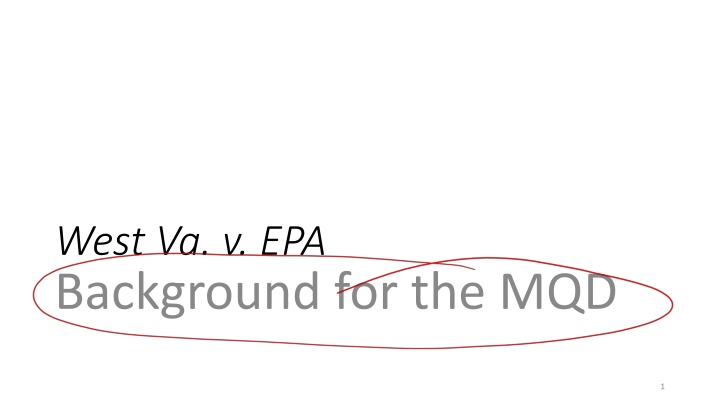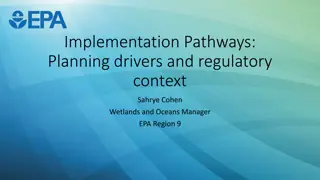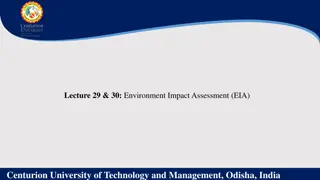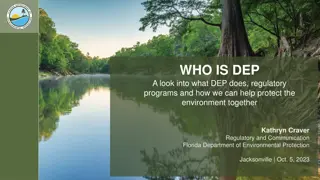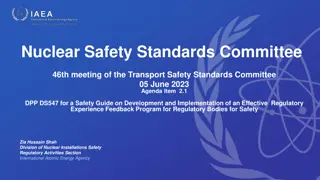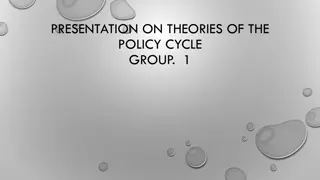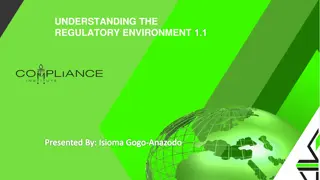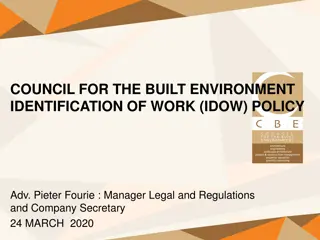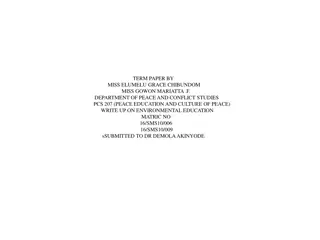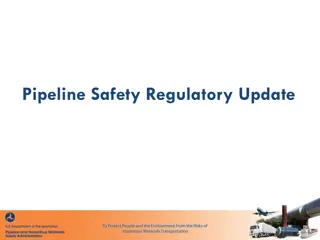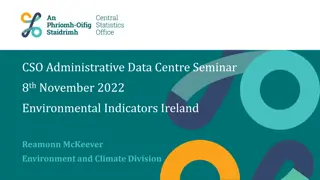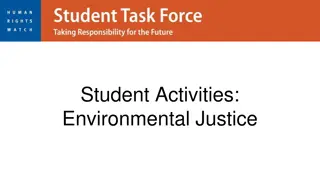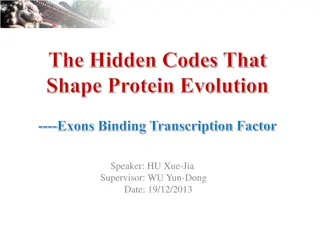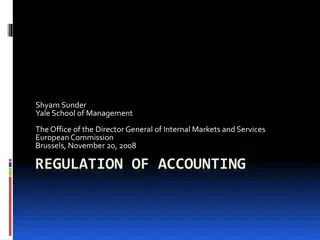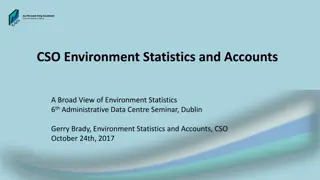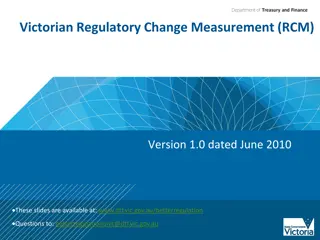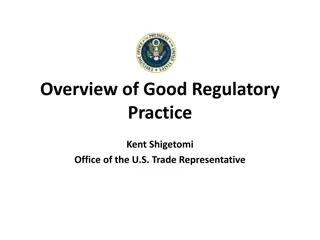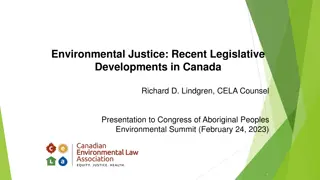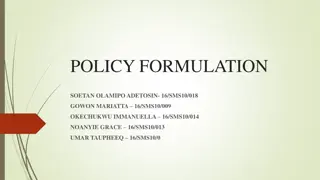Evolution of US Environmental and Regulatory Policy
The evolution of US environmental and regulatory policy is traced from the bipartisan period of the New Deal to current challenges in addressing issues like climate change and COVID-19. Key transitions include bipartisan support for major environmental laws, the Reagan shift towards smaller government, and the lack of bipartisan cooperation in recent years leading to difficulties in amending existing laws to address new challenges.
Download Presentation

Please find below an Image/Link to download the presentation.
The content on the website is provided AS IS for your information and personal use only. It may not be sold, licensed, or shared on other websites without obtaining consent from the author.If you encounter any issues during the download, it is possible that the publisher has removed the file from their server.
You are allowed to download the files provided on this website for personal or commercial use, subject to the condition that they are used lawfully. All files are the property of their respective owners.
The content on the website is provided AS IS for your information and personal use only. It may not be sold, licensed, or shared on other websites without obtaining consent from the author.
E N D
Presentation Transcript
West Va. v. EPA Background for the MQD 1
The Bipartisan Period Modern adlaw starts with the New Deal in the 1930s. The court pushes back with the non-delegation cases, but reconsiders when the president runs against the court in the 1936 election and wins by a landslide. (The switch in time that saved nine.) Congress builds the administrative state to fight WWII. Congress continues to legislate major programs to build the economy and reduce inequality in the post-war period through the Great Society program in the 1960s. The major environmental laws are passed late 1960s through the late 1980s. These are bipartisan laws and, once passed, there were bipartisan majorities to amend them to fix problems and address court rulings. There were bitter divisions in the US during this period, including the Vietnam War and the Civil Rights movement, but Congress still could find common ground to pass bipartisan major legislation. The Supreme Court crafts our modern due process jurisprudence during this period but is not hostile to regulation or agency power. 2
The Reagan Shift: Government as the Problem While Nixon was a Republican, he was also the last of the New Deal presidents. He believed in major government programs and government intervention into the economy. He supported passing environmental laws and created the EPA. Reagan ran on the rhetoric of government as the enemy and regulation as a burden on the economy. Chevon is decided during this period. While the Court rules for the EPA, remember that the case is about the EPA choosing the weaker regulatory strategy under the CAA. (Justice Gorsuch s mother was the scandal plagued EPA secretary under Reagan.) Reagan establishes the modern Republican party position against taxes and government social welfare programs. The Bush I presidency does not push this agenda. The last of the major bipartisan environmental laws are passed during his presidency. 3
From Clinton to the Present Since the Bush I presidency, Congress has not passed any major bipartisan regulatory program or long-term social welfare programs. The Affordable Care Act (ACA) was passed without Republican votes and the COVID benefits programs were all short-term. The Republicans have tried dozens of times to repeal the ACA and have refused to support amendments to improve the program. It has also been impossible to amend major programs to fix problems or address new risks, such as climate change. Republican presidents have made the majority of Supreme Court appointments during this period. These judges reflect the anti-regulatory bias of the administrations that appointed them. 4
Working up to the MQD As lawyers, we use the law that we have to help our clients. If Congress cannot amend existing laws or pass new ones to address new challenges like COVID and climate change, we try to find regulatory power in the existing laws. We looked at this in operation in Mass. v. EPA, which used the broad language of the CAA to create a regulatory path for GHGs. We saw this fail in Brown and Williamson, because the Court found that while the naked language of the law supported the regulation of tobacco, the result conflicted with obvious Congressional purpose. In recent cases, the court found that the CDC could not impose a foreclosure moratorium and OSHA could not impose a COVID testing requirement. In these cases, the court found that the text of the law might support the agency actions, but that it was contrary to the historical actions of the agency and the court s reading of Congressional intent. These cases did not hold that Congress could not give the agencies these powers, only that it had not done so by clear statutory language. (Not Nondelegation Doctrine) 5
West Virginia v. EPA, 597 U.S. ___ (2022) 6
Procedural History In 2015, the Obama administration promulgated rules regulating GHG emissions from new and existing coal fired electrical generating stations. The new plant rule was not challenged because no utility is planning new coal plants in the US. The rule for existing coal plants Clean Power Plan (CPP) - was enjoined through direct appeal to the USSC (a first) and litigation proceeded in the DC Circuit. In 2019, the Trump administration promulgated a new rule that replaced the Obama CPP. The Trump rule was enjoined, technically resurrecting the still enjoined CPP. The Biden administration tells the DC Cir that it does plans to replace the CPP and asks the court to dismiss the case as moot. The DC Circuit decides the case and finds that the Trump rule was improper, thus the still enjoined CPP was not replaced. The Republican state attorneys general appeal to the USSC, which grants cert. and produces this opinion. 7
The Major Questions Doctrine Where the statute at issue is one that confers authority upon an administrative agency, that inquiry must be shaped, at least in some measure, by the nature of the question presented whether Congress in fact meant to confer the power the agency has asserted. In the ordinary case, that context has no great effect on the appropriate analysis. Nonetheless, our precedent teaches that there are extraordinary cases that call for a different approach cases in which the history and the breadth of the authority that [the agency] has asserted, and the economic and political significance of that assertion, provide a reason to hesitate before concluding that Congress meant to confer such authority. (Examples omitted) All of these regulatory assertions had a colorable textual basis. And yet, in each case, given the various circumstances, common sense as to the manner in which Congress [would have been] likely to delegate such power to the agency at issue made it very unlikely that Congress had actually done so. Nor does Congress typically use oblique or elliptical language to empower an agency to make a radical or fundamental change to a statutory scheme. Agencies have only those powers given to them by Congress We presume that Congress intends to make major policy decisions itself, not leave those decisions to agencies. (West Va. V. EPA) 8
What is the Major Question in West Va. v. EPA? In arguing that Section 111(d) empowers it to substantially restructure the American energy market, EPA claim[ed] to discover in a long-extant statute an unheralded power representing a transformative expansion in [its] regulatory authority. What about Mass. v. EPA? The majority does not mention the case. Wasn t that where the power to regulate GHGs was discovered? Should it be overruled, rather than ignored? Is a plan to reduce the % of power generated by coal over a period of years substantially restructuring the American energy market? Should it matter that even if the Biden administration tried to enforce it, the utility industry has already met its requirements? Without any notice by the American economy? Is this about 111(d) or about the power of the EPA to regulate GHGs? 9
The Failure to Amend the CAA Finally, we cannot ignore that the regulatory writ EPA newly uncovered conveniently enabled it to enact a program that, long after the dangers posed by greenhouse gas emissions had become well known, Congress considered and rejected multiple times. Brown & Williamson, 529 U.S. at 144. At bottom, the Clean Power Plan essentially adopted a cap-and-trade scheme, or set of state cap-and-trade schemes, for carbon. Congress, however, has consistently rejected proposals to amend the Clean Air Act to create such a program. . . . When Congress considers amendments to law and rejects them, it is traditionally taken as showing that Congress does not intend for the underlying law to regulate the activity. [But does this have the same persuasiveness when Congress is paralyzed and cannot muster the votes to either add powers or weaken them?] 10
Did the Court need the MQD in this Case? The dissent makes an impassioned argument that the CAA supports the regulation of GHGs generally and through section 111(d). This is as much based on the danger of climate change as on the text of the CAA. But is this Disney s rule in operation: Wishing will make it so? The dissent is partially right - climate change is the major regulatory and national security issue for the rest of your lives. But there are major structural conflicts with regulating GHGs under the CAA that would justify holding that it does not provide authority for the CPP or other GHG regulations. At the core, the CAA is about controlling local pollution levels based on their effects on the local population. GHGs do not fit this model. The court did not need the MQD in this case. Administrative lawyers worry that the MQD a tool to give court s the power to kill any regulation that they do not like, with the knowledge that a paralyzed Congress cannot fix the statute to allow regulation. 11
Justice Gorsuchs Triggers for the MQD First, this Court has indicated that the doctrine applies when an agency claims the power to resolve a matter of great political significance, or end an earnest and profound debate across the country . . . . Second, this Court has said that an agency must point to clear congressional authorization when it seeks to regulate a significant portion of the American economy, or require billions of dollars in spending by private persons or entities. . . . Third, this Court has said that the major questions doctrine may apply when an agency seeks to intrud[e] into an area that is the particular domain of state law. . . . Are these objective triggers? 12
Stopped here 13
Justice Gorsuchs Standards for a Clear Statement First, courts must look to the legislative provisions on which the agency seeks to rely with a view to their place in the overall statutory scheme. [O]blique or elliptical language will not supply a clear statement. . . . Second, courts may examine the age and focus of the statute the agency invokes in relation to the problem the agency seeks to address. . . . [A]n agency s attempt to deploy an old statute focused on one problem to solve a new and different problem may also be a warning sign that it is acting without clear congressional authority. What about new problems, such as COVID? Third, courts may examine the agency s past interpretations of the relevant statute. A contemporaneous and long-held Executive Branch interpretation of a statute is entitled to some weight as evidence of the statute s original charge to an agency. . . . Fourth, skepticism may be merited when there is a mismatch between an agency s challenged action and its congressionally assigned mission and expertise. . . . [tobacco] 14
The Regulatory Impact of the MQD Lawyers often read statutes in ways that help their clients but go against the policy goals of Congress. (Think finding loopholes, the major goal of tax lawyers.) As a neutral proposition, asking Congress to specifically speak to new expansions of agency power can help protect separate of powers by taking the Court out of the role of empowering lawyers to use statutes in ways that violate Congressional policy. When Congress is paralyzed, the MQD empowers the side that opposes change. The opponents of climate change mitigation through the CAA could block it by amending the CAA. But they cannot get the votes. By requiring Congress to amend the CAA to regulate GHGs, despite there being a reading of the CAA that would allow it, the MQD is anti-regulatory rather than neutral. This status quo bias is not necessarily wrong. It becomes a partisan issue when it is not applied even handedly. The court has been criticized for allowing aggressive readings of statutes when it likes the result blocking immigration is an example and imposing a strict application of the MQD for regs it does not like, such as climate change mitigation. Let s look at the standards in West Va. v. EPA and see whether they are objectively neutral or subject to flexible interpretation. 15
The MQD and Chevron In the original Chevron Step 1, the court determines if the statute bans the agency activity or would allow it. This was classic statutory interpretation if the court found that action was allowed under the statute, but not clearly specified, it went to Step 2 and decided if the action was reasonable. This was modified by Brown and Williamson, where the Court also looked at other legislation to see it indicated that Congress did not want the agency to regulate tobacco, even if it the language of the FDCA might support it. The MQD goes beyond Brown and Williamson and asks the policy question is this what Congress intended? As we see in West Va. v. EPA, the court makes this call without the searching analysis it used in Brown and Williamson. The dissent criticizes the majority for ignoring the potential support for the regulation in the text of the statute. 16
Does the MQD Overrule Chevron? Chevron is not mentioned in the majority opinions and was not mentioned by any side during the oral arguments in the case. As Roberts demonstrates in this case, the court applies the MQD first to determine if Congress intended to give the agency the power it is claiming. Assume the court finds the necessary clear statement from Congress. Is this the same as finding that Congress authorized the action in Chevron Step 1? If so, then the agency can act and you do not need Step 2. Is it possible to meet the clear statement requirement with a statute that is ambiguous enough to require Chevron Step 2? These are unclear because the court has only applied the MQD when it is ruling against agencies. 17
When Might a Court Still Use Chevron? Assume that Congress amends the CAA to say that the EPA should use all appropriate means it determines necessary to mitigate climate change, and that all contrary provisions of the CAA are preempted. This would be a clear statement that the EPA has the power to regulate GHGs, but it would still require the court to use Step 2 to determine if a particular regulatory action is reasonable. If the court does not find that the MQD applies, does Chevron apply? The long-term fate of Chevron is uncertain. Remember the Goldberg case from adlaw? It was never overruled, but it was also not used after Mathews. The fate of Chevron will depend on whether the Court uses the MDQ to require an unambiguous delegation of specific powers. This would eliminate the need for Step 2. It would also make it difficult for agencies to use their expertise to address new problems or refine regulatory strategies without constant legislation from Congress. 18
When do the Tests Matter? #1 rule courts do not make decisions based on jurisprudential tests. They use tests to rationalize the decisions after they are made. Your job is to convince the court to rule for your client. You will do that with the facts. First, you have to tell a story that makes those facts fit the necessary law to get before the court. (Standing, etc.) Then you have to convince the judge to rule for you based on those facts. You need to understand how to present your facts and law so that the judge wants to rule for you. The tests are a way to show judges how to explain why they ruled for your client, once you have convinced them that they want to rule for your client. 19
Incorporating the MQD into Practice You must explicitly address the MQD. If you represent the agency, start with whether this is important enough to justify the MQD, then how you see the law providing that clear statement. You may or may not want to mention Chevron, but you should explain why your action is reasonable, as required by Step 2. This is important if the court gets past the MQD. If you are opposing the agency, then you want to show why the MQD applies and why there is no clear statement in this case. Again, you may not want to mention Chevron, but you should explain why the agency action is not reasonable, if the court gets past the MQD. While MQD is a federal doctrine, expect some trickle down to state court. It cannot hurt to do the same analysis in state court. The heart of the MQD is common sense, not federal law. You have to convince the state judge to want to rule for you, just as you do the federal judge. 20
